#Quantitative descriptive research
Explore tagged Tumblr posts
Text
Quantitative Descriptive Research: Characteristics, Methods, and Examples
Quantitative descriptive research helps businesses and researchers analyze numerical data to identify trends and patterns in a population. This method focuses on the "what" rather than the "why" or "how," using large sample sizes, structured surveys, and objective statistical analysis to generate insights that inform data-driven decisions. Learn about its key features, methods like surveys and observations, and practical applications in various industries.
0 notes
Text
Characteristics of Quantitative Descriptive Research

Quantitative descriptive research focuses on collecting numerical data to objectively analyze and summarize patterns or trends. Often used in quantitative market research services, it emphasizes generalizability to larger populations, ensuring replicability and consistency of findings. This method provides predictability by identifying measurable patterns for data-driven decision-making.
0 notes
Text
5 Methods of Data Collection for Quantitative Research
Discover five powerful techniques for gathering quantitative data in research, essential for uncovering trends, patterns, and correlations. Explore proven methodologies that empower researchers to collect and analyze data effectively.
#Quantitative research methods#Data collection techniques#Survey design#Statistical analysis#Quantitative data analysis#Research methodology#Data gathering strategies#Quantitative research tools#Sampling methods#Statistical sampling#Questionnaire design#Data collection process#Quantitative data interpretation#Research survey techniques#Data analysis software#Experimental design#Descriptive statistics#Inferential statistics#Population sampling#Data validation methods#Structured interviews#Online surveys#Observation techniques#Quantitative data reliability#Research instrument design#Data visualization techniques#Statistical significance#Data coding procedures#Cross-sectional studies#Longitudinal studies
1 note
·
View note
Text
Men Underestimate and Women Overestimate Their Own Sexual Violence
Time for an excellent new (2024) article "Gender Differences in Sexual Violence Perpetration Behaviors and Validity of Perpetration Reports: A Mixed-Method Study".
What this study did:
This study asked 23 men and 31 women to "think out loud while privately completing [the Sexual Experiences Survey-Short Form Perpetration (SES-SFP) survey] and to describe (typed response) behaviors that they reported having engaged in on the SES". The researchers asked anyone who "reported no such behavior ... to describe any similar behaviors they may have engaged in". They then analyzed differences in the quantitative responses (numerical values on the SES) and the qualitative responses (written descriptions and think-aloud audio).
What this study found (broad strokes):
Men’s sexual violence (SV) perpetration was more frequent and severe than women’s
Men’s verbal coercion was often harsher in tone and men more often than women used physical force (including in events only reported as verbal coercion on the SES)
Women often reported that their response to a refusal was not intended to pressure their partner or obtain the sexual activity*
Two women also mistakenly reported experiences of their own victimization or compliance (giving in to unwanted sex) on SES perpetration items, which inflated women’s SV perpetration rate
Quantitative measurement can miss important qualitative differences in women and men’s behaviors and may underestimate men’s and overestimate women’s SV perpetration
*This phrasing is poor (in my opinion) the authors are emphasizing genuine differences in men and women's reported behavior for ambiguous situations (not just their internal intent). Specifically, women would endorse responses for behaviors that (most) people would not actually consider a form of sexual violence. For example, women often indicated that the behaviors they were reporting were all pre-refusal (i.e., the women stopped and respected when their partner said no/told them to stop). Other "seducing" behaviors (e.g., kissing/touching) were also reported by women because their partner ultimately refused. Men did not report these types of behaviors, which the authors suggest is possibly because women may be more likely to remember experiences where they wanted to engage in sex with someone who did not because this violates social norms. It's also possible that men are more likely to consider these behaviors acceptable provided they stop when refused. (Ironically this suggests that the anti-feminist hyperbole that people will start recording "normal sexual interactions" as violence ... has only affected women.)
Lots more details below the cut (I use a mix of - unmarked - quotes and paraphrasing):
Quantitative data
The overall prevalence of sexual perpetration of significantly inflated due to intentional over-sampling of likely perpetrators (particularly female perpetrators). This is reasonable because the authors are interested in examining differences among self-reported perpetrators, not in establishing incidence/prevalence rates.
Even without taking the qualitative aspects into consideration (i.e., looking only at the quantitative data), men reporting SV perpetration reported more frequent offenses than women (re-offended more often). Men were also more likely to report more severe acts of violence (per the original tactic-act, the tactic specific, and sexual act specific continua).
Differences in severity identified via qualitative analysis
Men’s verbal coercion was more often stronger; more deceptive, persistent, or intimidating; or otherwise harsher in tone (e.g., "She kept refusing to do anything with me. I remember saying to her “just cause you’re on your period doesn’t mean I can’t get head.” I then remember repeating my intentions with her and almost gaslighting her and making her feel that she must not love me."). Proportionally more men described continually asking or persisting after repeated refusals, getting angry, telling lies, making false promises, and trying to make their partner feel guilty.
Women’s verbal coercion was predominantly expressing disappointment or pouting after a single refusal (e.g., “I got upset and said whatever and rolled over the opposite way”)
Also a difference in intent that could only be identified in the qualitative data. 35% of women who perpetrated explicitly said they had not intended to pressure their partner, change their partner’s mind, or obtain the sexual activity after their partner refused (e.g., "I respected him not trying to do anything further, though, and did not attempt anything further."). No men explicitly said they had not intended to pressure their partner or obtain the sexual activity and [men] more often than women explicitly said that they had intended to (e.g., "I think it was one time where I just kept pressuring . . . Didn’t happen, but the pressure was there, that’s for sure. I definitely asked more than a couple times.")
A few of women’s SV perpetration behaviors appeared more like attempts to advocate for equity in their own sexual pleasure or to stick up for themselves in response to a partner’s coercion (e.g., "I really love receiving oral sex. But sometimes my partner ignores that and directly goes to the penetration. So, I stop him and make him do it because I also feel like being properly aroused to get a better sexual experience.")
False negatives
Some participants that did not mark any of the perpetration items still described similar experiences. Most were not coercive (e.g., asking and “respecting” a refusal, clarifying an unclear refusal) but a couple were clear false negatives. There appears to be an issue with some behaviors not clearly fitting into any of the described categories (e.g., Even the physical force SES items refer only to more extreme force (holding down, pinning arms, having a weapon).)
There were many more cases where a less severe offense was marked (i.e., coded as a true positive for perpetration but for incorrect offense in severity analysis). Specifically, men reported only verbal coercion but then described physical behaviors, so the tactic report was incorrect or incomplete (e.g., "We were experimenting with different things and I did not necessarily ask for their consent before putting my finger in their butt." was coded by one man as verbal coercion).
False negative may have occurred, in part, because behaviors that were themselves no different than those performed in consensual sex were not adequately captured. This is a problem given that previous qualitative research has also found that initiating or going ahead with penetration without asking or following a refusal is a common SV perpetration behavior used by men (i.e., this type of behavior may be recorded as either a false negative or a less severe offense in quantitative scales).
When women reported verbal coercion only, but then described initiating sexual acts without asking, they almost always initiated non-penetrative sexual acts in contrast to men who more often described penetrative sexual acts without asking.
The SES may underestimate use of physical force and, especially, men’s rape and attempted rape.
False positives
Some participants reported perpetration on the SES that their description showed was not forceful, coercive, or engaged in without consent or following a refusal. Men explained that they did not engage in the behavior, misread or misinterpreted the SES question, or clicked the wrong response. Some women reported these same problems, but two "were reports of victimization or giving in to unwanted sex" (i.e., mistakenly reported victimization as perpetration).
Notably, three out of the four men with false positives reported other instances of SV perpetration on the SES whereas two of the four women with false positives did not report other perpetration and, therefore, inflated women’s perpetration rate.
Taken together, our analysis of false negatives and false positives suggests that the SES likely underestimates men’s SV perpetration and overestimates women’s perpetration.
This doesn't even account for instances reporting no intent to perpetrate (as described above). But the fact that many women reported no intent may further support the conclusion that women overreport or are more likely to remember and report because their coercion violates social expectations
Verbalized thought processes
In general, most participants appeared to understand and interpret the SES as intended
But there was evidence that the distinction between attempted and completed acts on the SES may be unclear for some respondents (e.g, one woman said "I also don’t understand what they mean by “tried.” Like does this mean that . . . You simply spoke to them, and they said no? Does this mean that you were engaged in an act and they pushed you off? Or does this mean that something disrupted you? So, this question doesn’t seem very clear to me.")
Second, participants used different items on the SES to report having used a specific category of tactic that is not mentioned in the measure. For example, some participants described kissing and sexually touching their partner without asking to try to arouse them and reported this as verbal tactics to obtain non-penetrative sexual contact. This may have underestimated attempted and completed sexual coercion (because the intent was to engage in penetrative sex). It may also have overestimated non-consensual non-penetrative sexual contact category (the most frequent category for female offenders) since research also finds that partners often use nonverbal cues including kissing and touching to communicate about sexual interest.
There was also confusion about the meaning of “getting angry” or "showing displeasure". Some participants (particularly women) indicated these could refer to internal feeling as opposed to external expression or be a “normal human reaction to . . . feeling rejection” that does not necessarily include a purposeful attempt to manipulate.
Other problems: (1) confusion on if intoxication only applied to alcohol, (2) too many tactics listed in a single question resulting in confusion, (3) participant frequency estimates were rough estimates likely contributing to a significant underestimation problem, (4) participants wouldn't endorse items that specified "without consent" even if they later described coercive behaviors suggesting different phrasing may be needed, (5) participants reported shock at the severity of the tactics asked about, which may indicate SV is not normalized among non-perpetrators or may indicate that less severe tactics are not being captured
Concerning (4) above: Other research indicates that while conceptually narrower, asking about behaviors done after someone resisted or indicated “no” (i.e., post-refusal persistence) results in higher rates of self-reported SV perpetration than asking about behaviors done without consent or when the other person did not want to.
Citation: Jeffrey, Nicole K., and Charlene Y. Senn. “Gender Differences in Sexual Violence Perpetration Behaviors and Validity of Perpetration Reports: A Mixed-Method Study.” The Journal of Sex Research, Feb. 2024, pp. 1–16. DOI.org (Crossref), https://doi.org/10.1080/00224499.2024.2322591.
29 notes
·
View notes
Text
Understanding the Types of Literature Review: A Comprehensive Guide
Understanding types of literature review: A comprehensive guide.
Literature reviews are critical components of academic research that give an overview of the available knowledge relating to a particular topic. This helps to identify gaps, forms a basis for further research, and grounds the study on established theory and evidence. Literature reviews, however, do not fit in one single type. Rather they are of different types. Each depends on the purpose and approach of the research. Let's have a detailed view of the types of literature reviews. ### 1. Narrative Review
A narrative review, sometimes known as the traditional one, gives a general overview of research regarding a particular topic. It is descriptive and focuses on summarizing and synthesizing findings without much depth analysis.
Key Features:
Focuses on storytelling and descriptive summary. - Majorly used in fields such as humanities and social sciences.
Lacks a systematic methodology for selecting studies, which can lead to bias.
Purpose:
Narrative reviews are ideal for understanding a topic broadly and identifying general trends or patterns in the literature.
2. Systematic Review
A systematic review is a rigorous and structured approach to synthesizing research. It follows a predefined protocol to ensure transparency, reproducibility, and comprehensiveness.
Key Features:
Has explicit inclusion and exclusion criteria.
Is planned in databases systematically to find studies.
Keeps bias at a minimum by having a clear methodology.
Purpose:
Systematic reviews are applied to answer particular research questions, especially in fields like healthcare, psychology, and social sciences. Systematic reviews come with immense value because of their reliability and objectivity.
3. Meta-Analysis
A meta-analysis is a type of systematic review that pools data from many studies together using statistical methods to make their own synthesis, which tries to produce a quantitative overview of research findings.
Key Features:
Assumes all studies share similarities in methodology to compare them. - Offers results with statistical significance by combining data. - Is considered a demanding statistical process.
Meta-analyses are commonly used in medicine and psychology to determine the effectiveness of interventions or treatments. ***
4. Scoping Review
Scoping reviews are exploratory and aim to map the breadth and scope of research on a topic. Less focused on answering specific questions and more on identifying research gaps, they are considered exploratory. #### Key Features:
Wide inclusion criteria, casting a net to encompass all aspects of a topic. Does not critically evaluate the quality of included studies in depth. Often a precursor to a systematic review. #### Purpose:
Scoping reviews are suitable for nascent research areas or subjects where there are a few published studies to date.
5. Integrative Review
An integrative review combines qualitative and quantitative research to achieve a holistic understanding of the topic under review. * Key Features:
It integrates data based on diverse methodologies.
This integration encourages innovation.
It is useful in the development of theories or models * Purpose:
It is common to find such reviews in nursing, education, and healthcare research where mixed methods are often employed.
6. Critical Review
A critical review evaluates and critiques existing literature, often proposing new frameworks or perspectives.
Key Features:
Involves in-depth analysis and interpretation.
Challenges existing assumptions or theories.
Requires a strong theoretical foundation.
Purpose:
Critical reviews are ideal for advanced academic writing, such as dissertations and theoretical papers.
7. Theoretical Review
Theoretical reviews focus on examining theories related to a topic rather than empirical research.
Key Features:
Compares and contrasts different theoretical frameworks.
Identifies theoretical gaps.
Explores the evolution of ideas over time.
Purpose:
These reviews are often used in disciplines like sociology, philosophy, and psychology to refine or propose theoretical models.
8. Annotated Bibliography
A much simpler form of literature review is the annotated bibliography-an overview and critique of each source.
Key Features:
Lists sources with brief descriptions and critiques. Not synthesizing findings from the studies. Serves as a precursor to further developed reviews.
Purpose:
This type is commonly used for coursework or preliminary research to organize sources.
Conclusion
Each type of literature review has a specific purpose and is appropriate for a range of research objectives. Whether the use is about embracing broad trends in a narrative review or diving deep in statistical relationships as in meta-analysis, awareness of the types can guide you towards choosing the right approach for your study. The right type chosen ensures that your research not only becomes more robust but also relevant and impactful in its field. Mastering the art of literature review will keep researchers conversing effectively in the academic arenas while paving a way to make further discoveries.
Need expert guidance for your PhD, Master’s thesis, or research writing journey? Click the link below to access resources and support tailored to help you excel every step of the way. Unlock your full research potential today!

Follow us on Instagram: https://www.instagram.com/writebing/
#dissertation#phd student#thesis#phd life#grad school#phd research#exams#writingcitation#research#literature academia#english literature#literature quotes
12 notes
·
View notes
Text
By: Charles Q. Choi
Published: Mar 7, 2012
Chimpanzees have police, too. Now, researchers are discovering what makes these simian enforcers of the peace step into conflicts, findings that could help shed light on the roots of policing in humans.
Animals handle conflicts within groups in a variety of ways, such as policing, where impartial bystanders intercede when disputes crop up. Policing, which has been seen in chimps, gorillas, orangutans and other primates, differs from other forms of intervention in that such arbiters are neither biased nor aggressive — they are neither supporting allies nor punishing wrongdoers.
Policing is risky, however, since it involves approaching two or more combative squabblers, which may lead to would-be arbiters becoming the targets of aggression themselves. To find out why primate policing evolved despite such risk, scientists took a closer look at pol.
The researchers analyzed one group of chimpanzees in a zoo in Gossau, Switzerland, for nearly 600 hours over two years. This group experienced a great deal of social tumult — zookeepers there introduced three new adult female chimps, upsetting the former order, and a power struggle also led to a new alpha male. The investigators also looked at records of chimp policing behavior at three other zoos.
The scientists monitored ape social interactions, such as aggressive conflicts, friendly grooming and policing behavior. Policing could involve threatening both quarrelers in a conflict, or running between the antagonists to break up the squabble.
The researchers explored a couple of potential explanations for policing. For instance, policing might help high-ranking members of a group control rivals to keep themselves dominant, or to help keep potential mates from leaving the group. However, both explanations would require high-ranking males to be the arbiters — female chimps usually do not fight over rank, and female chimps are the most likely members to leave groups, not males. In contrast, the researchers found that police chimps were of both sexes. [8 Ways Chimps Act Like Us]
The researchers suggest policing helps improve the stability of groups, thus providing the arbiters with a healthy community to live in. Supporting this notion is the fact that arbiters were more willing to intervene impartially if several quarrelers were involved in a dispute, probably because such conflicts are more likely to jeopardize group peace.
"The interest in community concern that is highly developed in us humans and forms the basis for our moral behavior is deeply rooted — it can also be observed in our closest relatives," said researcher Claudia Rudolf von Rohr at the University of Zurich.
The scientists detailed their findings online today (March 7) in the journal PLoS ONE.
--
Abstract
Because conflicts among social group members are inevitable, their management is crucial for group stability. The rarest and most interesting form of conflict management is policing, i.e., impartial interventions by bystanders, which is of considerable interest due to its potentially moral nature. Here, we provide descriptive and quantitative data on policing in captive chimpanzees. First, we report on a high rate of policing in one captive group characterized by recently introduced females and a rank reversal between two males. We explored the influence of various factors on the occurrence of policing. The results show that only the alpha and beta males acted as arbitrators using manifold tactics to control conflicts, and that their interventions strongly depended on conflict complexity. Secondly, we compared the policing patterns in three other captive chimpanzee groups. We found that although rare, policing was more prevalent at times of increased social instability, both high-ranking males and females performed policing, and conflicts of all sex-dyad combinations were policed. These results suggest that the primary function of policing is to increase group stability. It may thus reflect prosocial behaviour based upon “community concern.” However, policing remains a rare behaviour and more data are needed to test the generality of this hypothesis.
==
"mOrALiTy cOmEs FrOm GoD!!1!"
Even chimps know you don't "defund the police."
#evolution#chimpanzee#police officer#defund the police#morality#religious morality#social cohesion#conflict resolution#social stability#social instability#religion is a mental illness
13 notes
·
View notes
Text
The Ultimate Data Collection Handbook: Exploring Methods, Types, and Advantages

Data collection is a fundamental part of any research, business strategy, or decision-making process. Whether you're a student, a professional, or just curious about how data is gathered and used, understanding the basics of data collection can be incredibly useful. In this guide, we'll explore the methods, types, and benefits of data collection in a way that’s easy to understand.
What is Data Collection?
Data collection is the process of gathering information to answer specific questions or to support decision-making. This information, or data, can come from various sources and can be used to make informed decisions, conduct research, or solve problems.
Methods of Data Collection
Surveys and Questionnaires
What Are They? Surveys and questionnaires are tools used to gather information from people. They can be distributed in person, by mail, or online.
How Do They Work? Respondents answer a series of questions that provide insights into their opinions, behaviors, or experiences.
When to Use Them? Use surveys and questionnaires when you need to gather opinions or experiences from a large group of people.
Interviews
What Are They? Interviews involve asking questions to individuals in a one-on-one setting or in a group discussion.
How Do They Work? The interviewer asks questions and records the responses, which can be either structured (with set questions) or unstructured (more conversational).
When to Use Them? Use interviews when you need detailed, qualitative insights or when you want to explore a topic in depth.
Observations
What Are They? Observations involve watching and recording behaviors or events as they happen.
How Do They Work? The observer notes what is happening without interfering or influencing the situation.
When to Use Them? Use observations when you need to see actual behavior or events in their natural setting.
Experiments
What Are They? Experiments involve manipulating variables to see how changes affect outcomes.
How Do They Work? Researchers control certain variables and observe the effects on other variables to establish cause-and-effect relationships.
When to Use Them? Use experiments when you need to test hypotheses and understand the relationships between variables.
Secondary Data Analysis
What Is It? This method involves analyzing data that has already been collected by someone else.
How Does It Work? Researchers use existing data from sources like government reports, research studies, or company records.
When to Use It? Use secondary data analysis when you need historical data or when primary data collection is not feasible.
Types of Data
Quantitative Data
What Is It? Quantitative data is numerical and can be measured or counted.
Examples: Age, income, number of products sold.
Use It When: You need to quantify information and perform statistical analysis.
Qualitative Data
What Is It? Qualitative data is descriptive and involves characteristics that can be observed but not measured numerically.
Examples: Customer feedback, interview responses, descriptions of behavior.
Use It When: You need to understand concepts, opinions, or experiences.
Benefits of Data Collection
Informed Decision-Making
Data provides insights that help individuals and organizations make informed decisions based on evidence rather than guesswork.
Identifying Trends and Patterns
Collecting data allows you to identify trends and patterns that can inform future actions or strategies.
Improving Services and Products
By understanding customer needs and preferences through data, businesses can improve their products and services to better meet those needs.
Supporting Research and Development
Data is crucial for researchers to test hypotheses, validate theories, and advance knowledge in various fields.
Enhancing Efficiency
Data helps in streamlining processes and improving operational efficiency by highlighting areas that need attention or improvement.
Conclusion
Understanding the methods, types, and benefits of data collection can greatly enhance your ability to gather useful information and make informed decisions. Whether you're conducting research, running a business, or just curious about the world around you, mastering data collection is a valuable skill. Use this guide to get started and explore the many ways data can help you achieve your goals.
To know more: A Guide to Data Collection: Methods, Types, and Benefits
Outsource Data Collection Services
5 notes
·
View notes
Text
i think one of the biggest changes in terms of the whole concept of j*b hunting these days is how when we were younger and just out of art school a lot of emphasis was put on our 'thesis' as an artist. we were taught how to summarize our approach to art in concise and clear statements that could be read by both industry people and laymen on a gallery wall.
our thesis was supposed to be about how we Thought.
because so much of art is understanding how to deal with creative thinking and take the process of having an idea, walking through each step to turn it into reality.
but now? now apparently the only thing recruiter want to see is quantity and corporate speak descriptions of experience. its really odd. i have been on the other end of hiring more often than i have been unemployed and usually when im looking at candidates i was not prioritizing experience and more looking at the artist's attitude towards creating. i was looking for traditional skills that could be developed. pipelines can be taught, software can be taught. but that eye for sculpting appeal is much, much harder to capture. the raw talent of being able to break down texturing and painting. but we were a small team where i as the art director could individually review each applicants portfolio and scan the resume (people only sent c*over letters for very important things back then and rarely was our research team considered important)
with A*I and this...it feels like the industry is trying to shove the risk and unknown out of creativity through making it a factory product, without understanding that conceptual non quantitative thinking is integral to creativity. and truly it makes my head spin. cognitive dissonance for real
8 notes
·
View notes
Text
Part 4: doing and writing up Ur thesis
Scholarly research should be both replicable and verifiable. By replicable, we mean that it should be clear how the research was carried out, allowing researchers to replicate it in order to gather more evidence for a conclusion. By verifiable, we mean that it should be clear how a researcher obtained the data and what argumentation underlies the conclusion. In order to be able to assess the verifiability and the replicability, the reader should be able to verify your sources, and everything should be written down clearly.
In addition, the reader should be able to follow the argumentation precisely and retrieve all the information they need to evaluate the research.
Academic skills:
■■ Setting up a quantitative research study.
■■ Conducting, transcribing, and coding interviews.
■■ Organizing and recording data.
■■ Academic writing.
■■ Citing
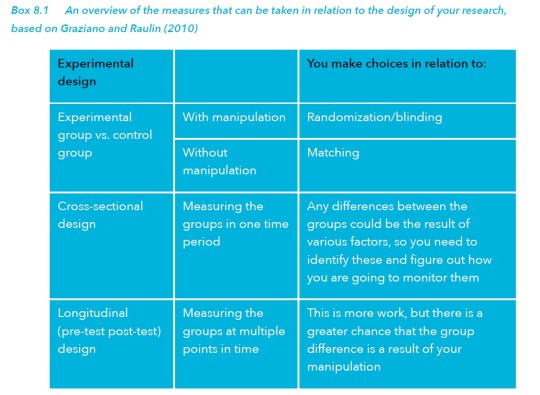
here are some tips:
Try to get used to keeping a record of the steps in your thinking as you analyse your results
Organize and get familiar with ur data
##how to establish a clear argumentation structure.
when writing a text, you shouldn’t ask your readers to follow the path that you took; you should spare them the dead-end arguments, the misleading steps, and unnecessary detours. Instead, you should mark out the shortest, most logical route to your question, and subsequently how you got from your results to your conclusion. In interdisciplinary texts in particular, where you need to draw links between different perspectives, it is essential to have a clear argumentation structure.
Although you are supposed to indicate the path to the point you wish to make as clearly as possible, this does not mean that you should ignore any evidence that disputes your position. On the contrary, you are expected to reflect on potential objections when drafting a scholarly text. You can use potential objections to make your argument and position more nuanced and stronger, for example in the theoretical framework or the discussion section of a scholarly article.
When framing an argument, it is important to make it as clear and solid as possible. In doing so, watch out for the invalid arguments or ‘fallacies’ that can easily slip into texts. Fallacies may seem plausible at first glance, but they certainly don’t improve an argument.
fallacies to watch out for:
Circular reasoning
appeal to authority
the majority view
false links
logical fallacies
reversing the burden of proof
false opposition
the slippery slope
The structure is IMD
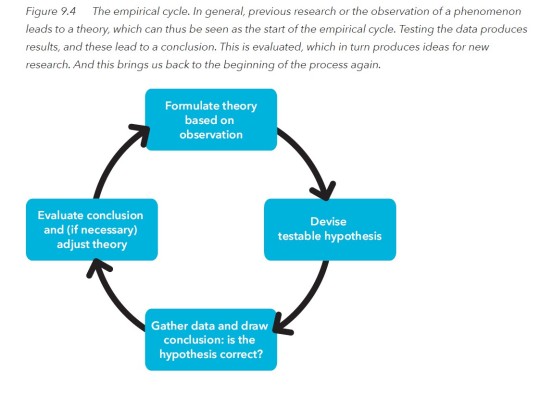
It can generally be said that the IMD structure is based on the ‘hourglass model’. This means that the content of the introduction and the conclusion is broad, whereas the content of the description in the middle section is specific and narrow. By ‘broad content’, we mean that the article begins and ends with general information.
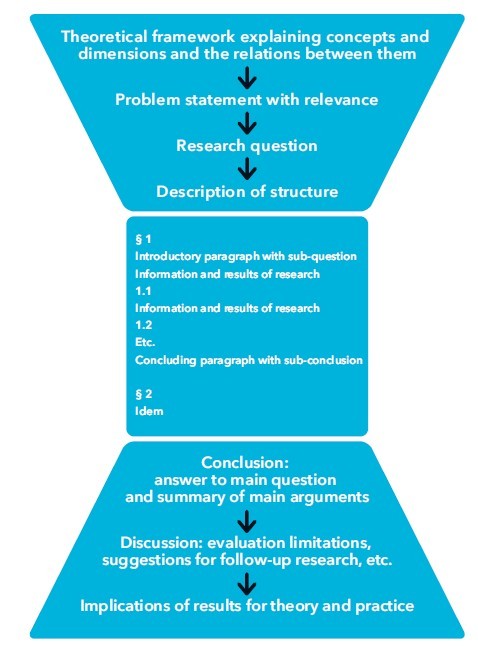
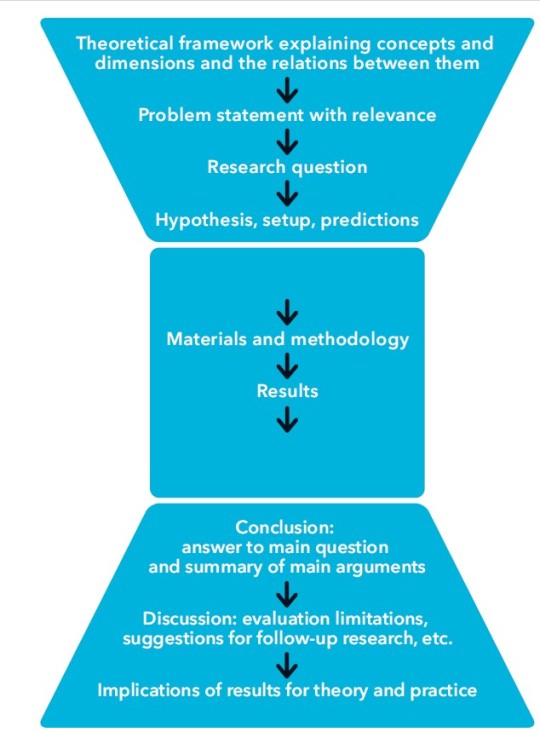
The introduction In terms of content, the introduction starts broadly and becomes narrower. This means that your introduction begins with a broad, general introduction, with the definitions, and an explanation of the concepts that you’re going to investigate. You also describe the potential relationship between these concepts (theoretical framework) and why investigating this relationship is relevant to society and/or scholarship (problem statement).
In some disciplines, it is common for this to be followed by a hypothesis: what answer can you expect to find, based on the literature? Finally, in many disciplines, it is common to provide a brief description of the experimental setup: what is your dependent variable, what is your independent variable, and which indicators are you going to use to test them? After the design section, you can conclude your introduction with a prediction or expectation, whereby you explain what you expect to come out of the variable.
2. The middle section:
the following factors are important for structuring the sections in the middle part:
■■ You should start each section with an introductory paragraph in which you explain why this subtopic is important for your main question. This allows you to make a transition from the previous section. By then formulating a sub-question you give direction to your section, so that the reader knows what you are going to investigate there.
■■Then you report the information and results from other research studies that are relevant to answering the sub-question. When describing the research, you should not discuss everything in minute detail, but only data that are relevant to your subtopic.
■■You need not wait until the end of your text (the conclusion/discussion) to evaluate the research. If your evaluation includes a critique of the research methodology, for example, it is more logical to put this straight after the description of the research in question. There should be a clear separation between the description of the research on the one hand, and the evaluation on the other hand.
Ensure that you always make it clear where the information is coming from. If you take others’ critical points on board, you should always cite the source. Usually, your own evaluation will be clear because the information is not accompanied by a citation, not because you’ve used the word ‘I’ (which should ideally be avoided).
■■Every section should finish with a short sub-conclusion. In this, you should summarize the most important results and conclusions once more, and you should state how the (possibly contradictory) results can be explained. Here, you also give an explicit and detailed answer to the sub-question you addressed in this section. In addition, this paragraph would be a good place for specific evaluations of the research studies discussed.
■■Ensure that every section has a heading and that the sections are linked effectively with good transitionary sentences. Adding well-chosen subheadings makes the literature review easier to follow. Pay attention both to the text of the section headings and to their place in the report. Choose short, substantive texts for the headings.
In a research article, you answer the research question by gathering and analysing data. This means that the middle section is subdivided into a methodology section (also known as the ‘materials and methods section’) and a results section. In the methodology section, you describe how the research was carried out, so the results can be interpreted and the experiment can be replicated. In the results section , you describe what came out of your experiment. Both parts lie on the narrowest point of the hourglass model.
Methodology:
In order to ensure replicability, it is important to describe this part in sufficient detail. In order to keep things readable, though, it is essential to be as concise as possible.
Under subjects of research, you describe the subjects in the broadest sense
You should also mention all of the conditions the research subjects had to meet
In the procedure section, the research design is described in full and in detail, often in chronological order.
By providing a good, comprehensive description of the procedure, you show that you have reflected carefully on the methodology of the research, taking account of controls, randomization, and any potential confounding factors.
In the analysis you describe what you did with your data. For example, which statistical test(s) you used to compare the impact of the independent variable(s) on the dependent variable(s).
In addition, you should mention the analysis program that you used here (such as SPSS or R, including the version number).
Results:
you are not concerned with the concepts or dimensions that you are researching, only with the indicators and their outcome measures. You describe the most important findings of the research as objectively as you can.
Therefore, in natural scientific research, it is important not to do any interpretation here. Interpreting, explaining, and concluding on the basis of these results should be saved for the discussion section.
Ensure that the most important results are also displayed in a figure, or possibly in a table. You should only use relevant data. Other data that support your research, but that are not essential to your story, can be put in an appendix.
Note that a figure or table should never be the only place where your data are presented: they should also be included in the text!
Keep it visually simple: ■■Don’t use colours or shading in the background. ■■Shading should only be used occasionally for very complex tables with lots of cells, and you should only use light grey. ■■Don’t use 3D (unless this is common in your field and data cannot be displayed in any other way) or icons (for example, piglets to represent meat production). The latter imply a certain interpretation of the data, something you want to avoid
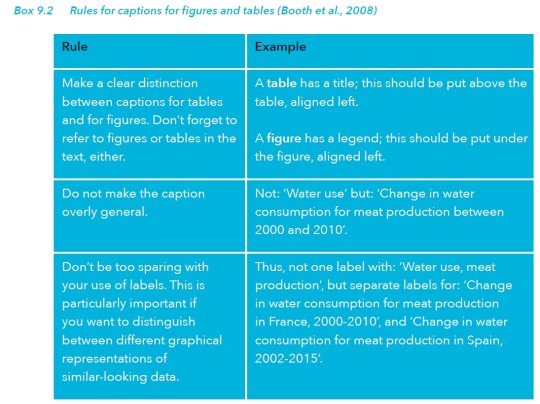
The discussion and the conclusion
You will use your results to draw a conclusion. In some disciplines, the conclusion usually falls under a separate heading; in others, the conclusion falls under the heading of the discussion section.
In a mirror image of the introduction, you start specifically (narrow), based on the research findings, and during the discussion the measurable variables are translated back into substantively broad concepts. Common elements in the discussion are a conclusion, evaluation, suggestions for follow-up research, limitations of the study, and implications.
It is common to start your discussion with a short summary of the most important results, and draw one overarching conclusion from this that directly answers the research question (and sub-questions).
Here you should only discuss the results that are already described in the middle section. Subsequently, you are going to evaluate
Consider the following: ■■What research questions are raised by your results? ■■What would you do differently if you were to research the topic again? How could you overcome the limitations ? ■■In what other context could you investigate the relationship between the concepts?
Valorization can be seen as a process of creating social value from knowledge, for example by transforming this knowledge into products, services, processes, and new enterprises.
In order to ensure that your scholarly research and knowledge contribute to a social goal, you can go through the different steps of the valorization process.
Think about who could benefit from your findings. These contacts can be a relatively easy way to start a dialogue and find out about the most recent developments in practice – and the extent to which your results connect with these. Make your idea specific.
You can make your idea more specific by asking the following questions:
What is the idea?
What problem or issue does it solve?
Who benefits from this solution?
What is the advantage of your solution compared to existing solutions?
From a substantive perspective, your story is now complete. You’ve written the introduction, the materials and methods section, the results, and the discussion. The last important elements of a research article are the title and the abstract.
The title of a research article should be informative and written as a fluent sentence, so that it clearly communicates the key conclusion of the report.
Checklist for the abstract 1 The aim of the research study (the problem statement and research question). 2 The methods that were used to answer the research question. 3 The results. 4 The conclusions that were drawn and their relevance.
Writing clearly: tips
Avoid discontinuous structures
The last part of the sentence is the stress position or topic position
The first part of a sentence is the part the reader needs in order to understand the logical progression of the text
Make effective use of verbs, as they indicate the actions that are taking place.
Avoid using the passive voice wherever possible
Note that one exception to this is active sentences containing personal pronouns (I, you, he, she, etc.)
In order to improve the clarity of your text, there are things you can bear in mind:
Be accurate in your descriptions
Be nuanced in your claims
Avoid ambiguity
Use demonstrative pronouns carefully
Avoid abbreviations
Finally, check your report carefully for minor errors that can detract from the content
Checklist: once you’ve finished writing, check your report for:
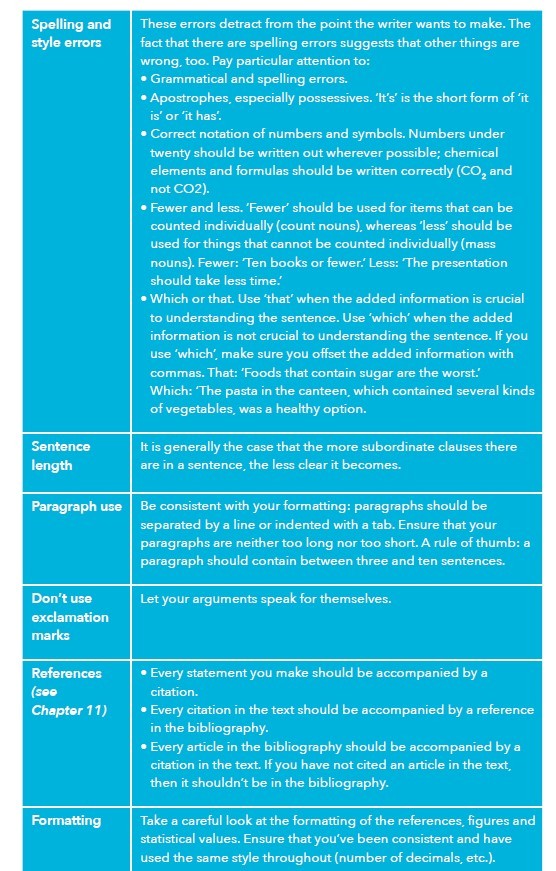
5 notes
·
View notes
Text
Understanding Research Methodologies and Design
Understanding Research Methodologies and DesignResearch is the cornerstone of progress in any field, from science and medicine to education and social sciences. To conduct meaningful research, one must first understand the fundamentals of research methodologies and design. These two concepts form the framework for systematic investigation and ensure the reliability and validity of results.This blog explores the essentials of research methodologies and design, offering a comprehensive guide for students, researchers, and enthusiasts.---What Is Research Methodology?Research methodology is the systematic plan for conducting research. It encompasses the tools, techniques, and procedures used to gather and analyze data, ensuring that the findings are accurate and relevant to the research question.Key components of research methodology include:1. Research PhilosophyPositivism: Focuses on observable phenomena and measurable facts.Interpretivism: Seeks to understand human behavior in its social context.Pragmatism: Combines positivism and interpretivism based on the research problem.2. Approach to ResearchDeductive Approach: Starts with a theory or hypothesis and tests it through data collection.Inductive Approach: Develops a theory based on observed patterns in the data.3. Types of ResearchQualitative: Explores experiences, concepts, and narratives. Common methods include interviews and thematic analysis.Quantitative: Measures variables numerically, often using surveys, experiments, and statistical analysis.Mixed Methods: Integrates both qualitative and quantitative approaches for a comprehensive understanding.---What Is Research Design?Research design is the blueprint of a study. It outlines the structure, techniques, and strategies for conducting research, ensuring the process is both effective and efficient.Key types of research design include:1. Exploratory Research DesignUsed when little is known about a problem.Methods include literature reviews, focus groups, and open-ended surveys.2. Descriptive Research DesignAims to describe characteristics or behaviors in detail.Surveys, observational studies, and case studies are common methods.3. Explanatory (Causal) Research DesignFocuses on identifying cause-and-effect relationships.Experimental designs, including randomized control trials, are widely used.4. Longitudinal vs. Cross-Sectional DesignsLongitudinal: Studies subjects over a long period to observe changes.Cross-Sectional: Collects data at a single point in time.---Steps to Create a Solid Research Design1. Define the Research ProblemStart with a clear and concise research question. For example, "What factors influence academic performance in college students?"2. Review LiteratureAnalyze existing studies to understand gaps and inform your design.3. Choose the Research MethodologyDecide whether your study will be qualitative, quantitative, or mixed-methods.4. Select Data Collection MethodsUse appropriate tools like surveys, interviews, experiments, or observational techniques.5. Plan Data AnalysisDecide on statistical methods or thematic approaches depending on your data type.6. Pilot the StudyConduct a small-scale trial to refine your methods.---The Importance of Ethical ConsiderationsEthics is integral to research methodologies and design. Ensure that your study respects the rights and dignity of participants by:Gaining informed consent.Ensuring confidentiality.Avoiding plagiarism and ensuring transparency in data reporting.---ConclusionMastering research methodologies and design is vital for conducting effective and credible research. By choosing the right approach, adhering to ethical practices, and meticulously planning each step, you can contribute valuable insights to your field of study.Whether you're a novice researcher or an experienced academic, understanding these concepts lays the foundation for impactful investigations. Keep learning, experimenting, and refining your approach to stay at the forefront of your discipline.
https://wa.me/919424229851/
2 notes
·
View notes
Text
Warning: lingerie, horny romantic dinner.
I
He wanted you to meet her, from one partner to the other. It was a plan proposed out of nowhere when Kishibe entered your apartment after drinking with his co-workers. His slurs were usually less coherent but his mind at that time seem lucid than it is intoxicated.
“Thought it was time,” Kishibe explained, “not like you’re something I wanted to hide especially her of all people.”
You were thrilled that your relationship with Kishibe had taken a serious turn. Although, you wouldn’t think Kishibe would’ve been fine throughout the changes of your relationship - he was open in seeing you as a warm body to fuck from time to time.
So, what made you agree?
Well, easy, you were attracted to him.
He’s a lot older than you are; a trait you’ve always denied yourself to accept but Kishibe pulls off the denial out of your chest. Also, he’s hot. Not ripped with chiseled abs kind of way but his body hardens with muscles he had sculpted from his line of work.
Combined with an intimidating expression, he easily managed to get into your panties with a mere smirk and an invitation for a drink in a hotel somewhere. Which ends up to be the alleyway near the bar.
Physically, you were sated and so did he.
Emotionally, that department has yet to stagnant from all the roller coaster you both experience.
But it’s fine. Committed relationships are new to him while you have experience it for the sake of settling in your thirties. A decision that failed miserably each time.
So you plan your wardrobe for the event. The venue had already been reserved and you questioned your lover thoroughly for preferences his partner and her girlfriends would’ve like to eat for that day.
Which he replied, “don’t think too much. Her girls aren’t invited. It’d be too much for you to meet fiends, four of them actually, for the first time.”
Oh, you thought, and step back from the conversation.
The assurance to not stress out over the meeting was, in a way, helpful but your mind sinks deeper to a realization you never thought of before. Devils and fiends and everything in between were something you only witness in the news. Sometimes the newspaper if you were at your parents’ house. Even chatters of concerned colleagues and children out-scaring each other.
But Kishibe hunts them down and kill them for a monthly salary that has extra zeroes at the end.
It widens your perspective of the man. Another side of him you haven’t seen and you don’t think you will - he is tight-lip with work related businesses.
Maybe it’s for the best.
And yet, you wish to be immersed by the tragedies and sorrow your lover experience on a regular business. You are partners, right? Through thick and thin, you and him should conquer any obstacle the other face together.
But, you knew he’ll deflect any sort of conversation concerning the topic. It’s for the best, he’ll say before adding another, I don’t think you’ll understand.
So, you researched everything by yourself.
From the shallow introduction to the theories, discussions, and cases you surf through the internet. Speculations were as abundant as there is an official and documented research - quantitively and qualitatively insignificant. Local and national accidents also tend to have vague descriptions on the matter and you can’t ask for help to know more about it either.
Not with Kishibe anyways.
But you’re also sure his partner wouldn’t be loose concerning their work as well.
With not much to dig deep in the internet, the books were just as helpless. Religions were used as some sort of answer with debates that begins years before and will end indefinitely.
So, now what? Nothing, really.
The search is done.
-
“So... your partner,” you start the conversation over a quiet dinner between the two of you. You prep the meal earlier than expected and have worn your sexiest lingerie underneath a dark shirt and denim shorts.
It’s a prize if Kishibe answers and will also be a prize if he doesn’t.
“What’s she like?” You murmured your question and stuffed your mouth with a handful of rice and side dishes. But you knew he picked it up and knows something’s going on in your pretty little head.
Nothing can escape him and that’s what you like about him. Despite how annoying it is.
Kishibe stops eating, his chopsticks placed on top of his bowl. He replied, “she’s stronger than me - older too.”
Now, that fascinates you.
The mortality rate of a hunter of is low. Kishibe already amazes you for being in the profession for so long with less of a hiccup. The scar was something you don’t mind, it’s a place you usually give him a kiss too.
For a woman to be in the profession far longer than Kishibe. Your mind just can’t stop running.
“Wow,” you mutter and continued, “no wonder she got four girlfriends.”
Kishibe snorts. “Hm, and I only have you.”
“What’s that supposed to mean?” You pouts at his comment, furthering his humor concerning his partner with a chuckle.
You gulp down your remaining grains of rice and gave him a glare which didn’t penetrate much as his eyes falls to your shirt. And so you followed his gaze, noticing a tiny piece of rice sticking to your skin. But that’s not all, what you think hides your lingerie was unforgiving with another fact you forget; it’s loose on you because it’s not yours.
And so a sleeve slides down from your shoulder.
The strap to your lingerie was exposed. It didn’t help that’s in a hot red shade which Kishibe actually likes. He even bought the set you’re wearing.
“Let’s just say you’re not going to be her fifth once you two finally meet,” Kishibe says while loosening his tie. You can’t help but close your legs, feeling your cunt throb in anticipation for dessert.
Part II
39 notes
·
View notes
Text
Your Guide to Success in Quantitative Research: 8 Practical Tips
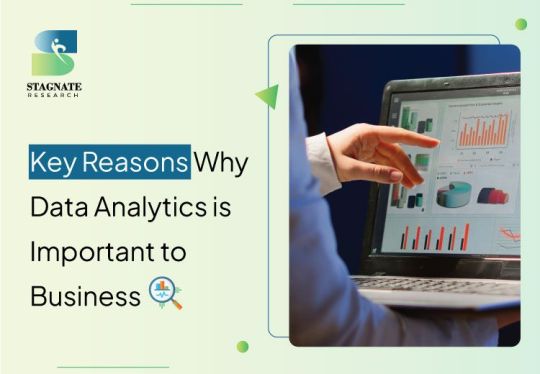
Quantitative research plays a crucial role in fields like social sciences, business, healthcare, and education. It provides numerical data that can be analyzed statistically to identify patterns, relationships, and trends. However, excelling in quantitative research requires more than just crunching numbers.
1. Start with a Clear Research Question
The foundation of any successful research is a well-defined research question. This question guides the entire study, determining your methodology, data collection, and analysis. Ensure that your research question is specific, measurable, and aligned with the purpose of your study.
For example, instead of asking, "How do students perform in school?" a clearer question might be, "What is the relationship between study hours and academic performance in high school students?"
Tip: Before starting, spend time refining your question. This will save you time and effort during the research process.
2. Choose the Right Research Design
Quantitative research can take many forms, including experiments, surveys, and observational studies. Choosing the right design depends on your research objectives and the type of data you need. Are you testing a hypothesis?
Tip: Match your research design with your objectives to ensure you’re collecting the right kind of data.
3. Use Valid and Reliable Instruments
The tools you use to gather data—whether they’re questionnaires, tests, or measuring devices—must be both valid (measuring what you intend to measure) and reliable (producing consistent results over time).
Tip: If you’re developing your own instrument, pilot it first with a small group to check its validity and reliability. If using an existing tool, review past studies to confirm it works well for your research population.
4. Select an Appropriate Sample Size
A common mistake in quantitative research is working with a sample size that’s too small, which can lead to unreliable or inconclusive results. On the other hand, excessively large samples can waste resources. To avoid these pitfalls, conduct a power analysis to determine the optimal sample size for your study.
Tip: Use tools like G*Power to calculate the right sample size based on your research goals and the expected effect size. This ensures your findings are statistically significant and applicable to a larger population.
5. Ensure Random Sampling for Representativeness
Your findings will only be meaningful if your sample represents the broader population you’re studying. Random sampling ensures that every individual in the population has an equal chance of being selected, reducing bias and increasing the generalizability of your results.
Tip: Use random sampling methods (e.g., simple random sampling, stratified random sampling) to ensure your data is as representative as possible.
6. Minimize Bias in Data Collection
Bias can creep into any research process, affecting the accuracy and fairness of your results. To reduce bias, carefully design your data collection process. For example, avoid leading questions in surveys and standardize how data is collected across all participants to prevent interviewer or observer bias.
Tip: Blind or double-blind studies can help minimize bias, especially in experiments where participants or researchers might be influenced by expectations.
7. Analyze Data Properly with the Right Statistical Tools
Once you’ve collected your data, the next step is analysis. Choosing the right statistical tests is essential to interpret your findings correctly. Descriptive statistics (like means and frequencies) give a broad overview, while inferential statistics (like t-tests, chi-squares, or regression analyses) help determine whether your findings are statistically significant.
Tip: If you’re unsure which test to use, consult a statistician or use resources like statistical decision trees to guide your choice based on your data type and research questions.
8. Interpret Results with Context and Caution
After analyzing your data, it’s tempting to jump to conclusions. However, quantitative research is not just about the numbers; it’s about what those numbers mean in context. Always interpret your results in relation to your research question and the existing body of knowledge.
Be cautious when generalizing your findings, especially if your sample size is small or non-representative. Additionally, consider the limitations of your study—were there any confounding variables, measurement errors, or external factors that might have influenced your results?
Tip: Be transparent about the limitations of your study. Acknowledging them strengthens the credibility of your research.
Conclusion
Mastering quantitative research requires attention to detail, a solid understanding of statistical methods, and a commitment to rigor throughout the process. By following these 8 practical tips—starting with a clear question, choosing the right design, using valid instruments, selecting the appropriate sample, minimizing bias, analyzing correctly, and interpreting results carefully—you’ll be well on your way to conducting successful and impactful quantitative research.
Read more: https://stagnateresearch.com/blog/how-to-excel-in-quantitative-research-8-essential-tips-for-success/
Also read: Project Management Service Company
data processing in research services
#onlineresearch#marketresearch#datacollection#project management#survey research#data collection company#business
3 notes
·
View notes
Text
Time to discuss on my main/side page, what the hell is a special interest?
Did I make this because I'm petty and hate people fake claiming others because of the term special interest? Yes.
So let's talk about it,
So what is autism in a brief summary?
Autism spectrum disorder (ASD) is a complex developmental condition involving persistent challenges with social communication, restricted interests and repetitive behavior. While autism is considered a lifelong disorder, the degree of impairment in functioning because of these challenges varies between individuals with autism.
Ethnicities such as a person of color, Asian, or other ethnicities may not present how a caucasian person would. A reason may be some non Caucasian's (a bodily white person) was taught it's okay to punish their children with physical punishments. And because of that some traits of autism such as autistic meltdowns may present in a different way and not in a way that you'd normally see it. Source and source
THIS DOSENT MEAN CAUCASIANS DO NOT GET PHYSICALLY PUNISHED. SOME DO. IT DEPENDS ON THE HOUSEHOLD AND WHAT THE PARENTS WERE TAUGHT
Brief description of types of interests. Source
Circumscribed Interest - an intense and restricted interest in objects or topics that often results in functional impairment.
Unusual Preoccupation — an intense interest in an object or topic that is unexpected for the child's age or development.
Atypical Attachment - an intense attachment to specific or unusual objects.
Moving on to the topic of discussion,
When we talk about special interests what do you think of? Trains, animals, maybe even math. And yes that is some others may have, but it's not limited to just those. Some people with autistic (not always the case but is pretty common) have those as a special interest. I know as a child I had a special interest of an owl. This would have me draw owls where ever and whenever, it was a favorite topic of mine. Much like how someone may enjoy rambling about certain shows, certain topics. These topics is to soothe the person in question, or to use as an award for good behavior. Think of it as you were gifted a golden sticker because you did well in class despite feeling overwhelmed and anxious, the sticker can provide an extra layer of praise and comfortability for the person.
When in school I know we had severely bad anger issues, which lead into fights, being explled and kicked out of school. However during that time a former in school the counselor gave me a stress toy that I took everywhere and had time where I needed time for myself. It was a way to cope with the stress that comes with my disorders including autism. Since I don't speak about having autism a ton, nor speak to a lot of people this may seem derange towards a normal person. But enough about me, let's go back to the academic sources rather than my rambling.
Neurotypical individuals also develop special interests, often in the form of hobbies. Although past research has focused on special interests held by children with autism spectrum disorder, little is known about their role in adulthood. The current study investigated differences in the content, number, and specificity of the special interests held by adult individuals with autism spectrum disorder and neurotypical individuals, using Internet discussion forums as a data source. Quantitative analysis of forum posts revealed significant differences between the diagnostic groups. Individuals with autism spectrum disorder reported having more interests in systemizing domains, more specific interests, and a greater number of interests overall than neurotypical individuals. Understanding special interests can lead to the development of educational and therapeutic programs that facilitate the acquirement of other important social and communication skills. Source
special interests are wrongly assumed to be obsessive. Even though persons with autism nay experience special interest as an 'addiction', they do not feel that they are unwanted or distressful (Baron-Cohen, 1989), as is the case in obsessive-compulsive conditions. Rather, they are a source of pleasure.
This poor understanding of the defining features of special interest is reflected by the fact that scholars use over 70 different term variants to describe such interests. By analysing the salience of these terms in 80 academic papers focussing on the subject, the author has found that 'special interests' is the most salient term, rather than 'circumscribed' and 'restricted' interests, or'obsessions'. The value of special interests to higher education becomes more clear when it is recognized that their defining features is an intrinsically motivation to know all there is to know about a subject without regard for the social or practical contexts in which it is embedded. In a rare study focussing on special interests in so-called 'high-functioning' adults, Aday (2011, p. 112) found that 85% of a sample of 150 reported one or more special interests; of this group, 90% pursued their interests) daily, and 35% for six hours a day. A larger and more recent study found that 65% of a sample of 687 adults with autism reported at least one special interest; 56% of the sample pursued their special interest(s) every day, for 0-2 hours by 31% and for 2-4 hours by 37% (Grove et. al., 2018, p. 4). Source
Some important information especially when it comes to mental health diagnosis'
Some people may opt to be self diagnosed because they were withheld of the acknowledgment they were diagnosed especially as an infant or child.
Does a parent have a right to receive a copy of psychotherapy notes about a child's mental health treatment?
No. The Privacy Rule distinguishes between mental health information in a mental health professional's private notes and that contained in the medical record. It does not provide a right of access to psychotherapy notes, which the Privacy Rule defines as notes recorded by a health care provider who is a mental health professional documenting or analyzing the contents of a conversation during a private counseling session or a group, joint, or family counseling session and that are separate from the rest of the patient's medical record. See 45 CFR
164.501. Psychotherapy notes are primarily for personal use by the treating professional and generally are not disclosed for other purposes. Thus, the Privacy Rule includes an exception to an individual's (or personal representative's) right of access for psychotherapy notes. See 45 CFR 164.524(a)(1)(i).
However, parents generally are the personal representatives of their minor child and, as such, are able to receive a copy of their child's mental health information contained in the medical record, including information about diagnosis, symptoms, treatment plans, etc.
Further, although the Privacy Rule does not provide a right
for a patient or personal representative to access psychotherapy notes regarding the patient, HIPAA generally gives providers discretion to disclose the individual's own protected health information (including psychotherapy notes) directly to the individual or the individual's personal representative. As any such disclosure is purely permissive under the Privacy Rule, mental health providers should consult applicable State law for any prohibitions or conditions before making such disclosures.
https://depts.washington.edu/bhdept/ethics-medicine/bioethics-topics/detail/82#:~:text=If%20the%20physician%20has%20some,justified%20to%20withhold%20truthful%20information.
Other recourses for autism and special interests
#did system#selfishness#endos dni#anti endo#fuck you endos#plural system#endos fuck off#not endo safe#endos aren't real#endos are ableist#endos do not interact#endos not for you#non traumagenic dni#autistic hyperfixation#autstic#actually diagnosed#actually traumagenic#actually dissociative#actually autistic#actually did#actually mentally ill#autism#important#research#psychology#special interest
3 notes
·
View notes
Note
hello meg! hope you're doing well!
i need some guidance related to academics, if you don't mind sharing. i need to do this research project on social psychology. i've taken psychology for the first time this semester in college, so i'm slightly overwhlemed by it. the only things our professor has told us about what she expects are: - needs to be related to social psychology - needs to include community outreach or a survey with at least 100 participants - needs to show the work of two months, do NOT pull together a short essay in like two days lol
so i'm thinking i might do something relating to how superstitions form. might include examples of celebrities and survey people on what sorts of superstitions they believe in/follow, and figure out the possible cultural contexts behind those.
do you have any tips for stuff i can do, since you've studied psychology?
So you need to consider 2 aspects here
1. The research aspect
when you say research project are you going to statistically analyze the data (from your surveys) and present it? Is it qualitative or quantitative? Do you have the tools to do the analysis? Or are you just expected to present the data using Descriptive stats?
2. The topic
I'd recommend making a mindmap for topics you're interested in, see if any connections come up, if there's interlinked facets you can explore together
Review existing literature on these topics, figure out how you want to approach it, what ontological stance you'll adopt, how you'll formulate the research question, etc.
If all you're asked to do is write a paper/essay about your survey, start looking for papers that support and go against your argument and modify your research question accordingly. Ik this sounds a bit too much but I promise once you pick a topic finding a theoretical basis will inform a lot of your work.
As for the domains you can work with, superstitions is a great idea! You can also look into groupthink and conformity along similar lines, or look for factors that lead to polarization. Prejudice, persuasion, prosocial behavior are some other examples. You can always dm me if you have specific questions!
0 notes
Text
Understanding Different Types of Variables in Statistical Analysis
Summary: This blog delves into the types of variables in statistical analysis, including quantitative (continuous and discrete) and qualitative (nominal and ordinal). Understanding these variables is critical for practical data interpretation and statistical analysis.

Introduction
Statistical analysis is crucial in research and data interpretation, providing insights that guide decision-making and uncover trends. By analysing data systematically, researchers can draw meaningful conclusions and validate hypotheses.
Understanding the types of variables in statistical analysis is essential for accurate data interpretation. Variables representing different data aspects play a crucial role in shaping statistical results.
This blog aims to explore the various types of variables in statistical analysis, explaining their definitions and applications to enhance your grasp of how they influence data analysis and research outcomes.
What is Statistical Analysis?
Statistical analysis involves applying mathematical techniques to understand, interpret, and summarise data. It transforms raw data into meaningful insights by identifying patterns, trends, and relationships. The primary purpose is to make informed decisions based on data, whether for academic research, business strategy, or policy-making.
How Statistical Analysis Helps in Drawing Conclusions
Statistical analysis aids in concluding by providing a structured approach to data examination. It involves summarising data through measures of central tendency (mean, median, mode) and variability (range, variance, standard deviation). By using these summaries, analysts can detect trends and anomalies.
More advanced techniques, such as hypothesis testing and regression analysis, help make predictions and determine the relationships between variables. These insights allow decision-makers to base their actions on empirical evidence rather than intuition.
Types of Statistical Analyses
Analysts can effectively interpret data, support their findings with evidence, and make well-informed decisions by employing both descriptive and inferential statistics.
Descriptive Statistics: This type focuses on summarising and describing the features of a dataset. Techniques include calculating averages and percentages and crating visual representations like charts and graphs. Descriptive statistics provide a snapshot of the data, making it easier to understand and communicate.
Inferential Statistics: Inferential analysis goes beyond summarisation to make predictions or generalisations about a population based on a sample. It includes hypothesis testing, confidence intervals, and regression analysis. This type of analysis helps conclude a broader context from the data collected from a smaller subset.
What are Variables in Statistical Analysis?
In statistical analysis, a variable represents a characteristic or attribute that can take on different values. Variables are the foundation for collecting and analysing data, allowing researchers to quantify and examine various study aspects. They are essential components in research, as they help identify patterns, relationships, and trends within the data.
How Variables Represent Data
Variables act as placeholders for data points and can be used to measure different aspects of a study. For instance, variables might include test scores, study hours, and socioeconomic status in a survey of student performance.
Researchers can systematically analyse how different factors influence outcomes by assigning numerical or categorical values to these variables. This process involves collecting data, organising it, and then applying statistical techniques to draw meaningful conclusions.
Importance of Understanding Variables
Understanding variables is crucial for accurate data analysis and interpretation. Continuous, discrete, nominal, and ordinal variables affect how data is analysed and interpreted. For example, continuous variables like height or weight can be measured precisely. In contrast, nominal variables like gender or ethnicity categorise data without implying order.
Researchers can apply appropriate statistical methods and avoid misleading results by correctly identifying and using variables. Accurate analysis hinges on a clear grasp of variable types and their roles in the research process, interpreting data more reliable and actionable.
Types of Variables in Statistical Analysis

Understanding the different types of variables in statistical analysis is crucial for practical data interpretation and decision-making. Variables are characteristics or attributes that researchers measure and analyse to uncover patterns, relationships, and insights. These variables can be broadly categorised into quantitative and qualitative types, each with distinct characteristics and significance.
Quantitative Variables
Quantitative variables represent measurable quantities and can be expressed numerically. They allow researchers to perform mathematical operations and statistical analyses to derive insights.
Continuous Variables
Continuous variables can take on infinite values within a given range. These variables can be measured precisely, and their values are not limited to specific discrete points.
Examples of continuous variables include height, weight, temperature, and time. For instance, a person's height can be measured with varying degrees of precision, from centimetres to millimetres, and it can fall anywhere within a specific range.
Continuous variables are crucial for analyses that require detailed and precise measurement. They enable researchers to conduct a wide range of statistical tests, such as calculating averages and standard deviations and performing regression analyses. The granularity of continuous variables allows for nuanced insights and more accurate predictions.
Discrete Variables
Discrete variables can only take on separate values. Unlike continuous variables, discrete variables cannot be subdivided into finer increments and are often counted rather than measured.
Examples of discrete variables include the number of students in a class, the number of cars in a parking lot, and the number of errors in a software application. For instance, you can count 15 students in a class, but you cannot have 15.5 students.
Discrete variables are essential when counting or categorising is required. They are often used in frequency distributions and categorical data analysis. Statistical methods for discrete variables include chi-square tests and Poisson regression, which are valuable for analysing count-based data and understanding categorical outcomes.
Qualitative Variables
Qualitative or categorical variables describe characteristics or attributes that cannot be measured numerically but can be classified into categories.
Nominal Variables
Nominal variables categorise data without inherent order or ranking. These variables represent different categories or groups that are mutually exclusive and do not have a natural sequence.
Examples of nominal variables include gender, ethnicity, and blood type. For instance, gender can be classified as male, female, and non-binary. However, there is no inherent ranking between these categories.
Nominal variables classify data into distinct groups and are crucial for categorical data analysis. Statistical techniques like frequency tables, bar charts, and chi-square tests are commonly employed to analyse nominal variables. Understanding nominal variables helps researchers identify patterns and trends across different categories.
Ordinal Variables
Ordinal variables represent categories with a meaningful order or ranking, but the differences between the categories are not necessarily uniform or quantifiable. These variables provide information about the relative position of categories.
Examples of ordinal variables include education level (e.g., high school, bachelor's degree, master's degree) and customer satisfaction ratings (e.g., poor, fair, good, excellent). The categories have a specific order in these cases, but the exact distance between the ranks is not defined.
Ordinal variables are essential for analysing data where the order of categories matters, but the precise differences between categories are unknown. Researchers use ordinal scales to measure attitudes, preferences, and rankings. Statistical techniques such as median, percentiles, and ordinal logistic regression are employed to analyse ordinal data and understand the relative positioning of categories.
Comparison Between Quantitative and Qualitative Variables
Quantitative and qualitative variables serve different purposes and are analysed using distinct methods. Understanding their differences is essential for choosing the appropriate statistical techniques and drawing accurate conclusions.
Measurement: Quantitative variables are measured numerically and can be subjected to arithmetic operations, whereas qualitative variables are classified without numerical measurement.
Analysis Techniques: Quantitative variables are analysed using statistical methods like mean, standard deviation, and regression analysis, while qualitative variables are analysed using frequency distributions, chi-square tests, and non-parametric techniques.
Data Representation: Continuous and discrete variables are often represented using histograms, scatter plots, and box plots. Nominal and ordinal variables are defined using bar charts, pie charts, and frequency tables.
Frequently Asked Questions
What are the main types of variables in statistical analysis?
The main variables in statistical analysis are quantitative (continuous and discrete) and qualitative (nominal and ordinal). Quantitative variables involve measurable data, while qualitative variables categorise data without numerical measurement.
How do continuous and discrete variables differ?
Continuous variables can take infinite values within a range and are measured precisely, such as height or temperature. Discrete variables, like the number of students, can only take specific, countable values and are not subdivisible.
What are nominal and ordinal variables in statistical analysis?
Nominal variables categorise data into distinct groups without any inherent order, like gender or blood type. Ordinal variables involve categories with a meaningful order but unequal intervals, such as education levels or satisfaction ratings.
Conclusion
Understanding the types of variables in statistical analysis is crucial for accurate data interpretation. By distinguishing between quantitative variables (continuous and discrete) and qualitative variables (nominal and ordinal), researchers can select appropriate statistical methods and draw valid conclusions. This clarity enhances the quality and reliability of data-driven insights.
#Understanding Different Types of Variables in Statistical Analysis#Variables in Statistical Analysis#Statistical Analysis#statistics#data science
4 notes
·
View notes
Text

By: Aaron Sibarium
Published: Jan 1, 2024
Harvard University president Claudine Gay was hit with six additional allegations of plagiarism on Monday in a complaint filed with the university, breathing fresh life into a scandal that has embroiled her nascent presidency and pushing the total number of allegations near 50.
Seven of Gay’s 17 published works have already been impacted by the scandal, but the new charges, which have not been previously reported, extend into an eighth: In a 2001 article, Gay lifts nearly half a page of material verbatim from another scholar, David Canon, a political science professor at the University of Wisconsin.
That article, "The Effect of Minority Districts and Minority Representation on Political Participation in California," includes some of the most extreme and clear-cut cases of plagiarism yet. At one point, Gay borrows four sentences from Canon’s 1999 book, Race, Redistricting, and Representation: The Unintended Consequences of Black Majority Districts, without quotation marks and with only minor semantic tweaks. She does not cite Canon anywhere in or near the passage, though he does appear in the bibliography.
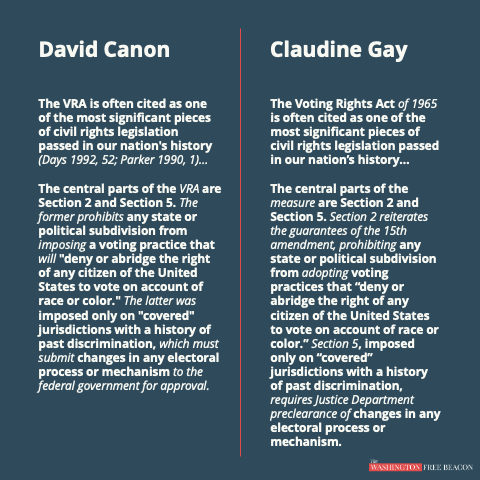
Beyond that, Gay’s first two footnotes are copied verbatim from Canon’s endnotes.
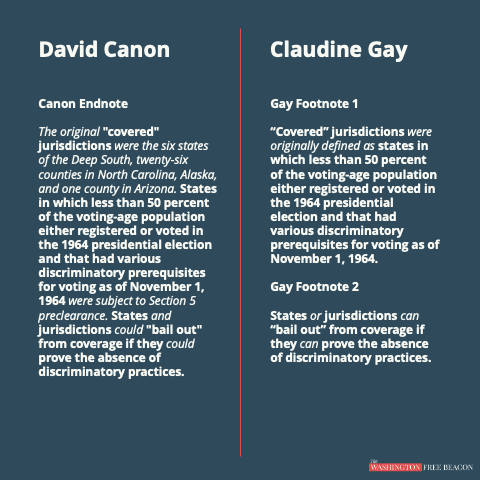
Canon, like several of the scholars Gay has quoted without attribution, insisted that she had done nothing wrong.
"I am not at all concerned about the passages," Canon told the Washington Free Beacon. "This isn't even close to an example of academic plagiarism."
Though Harvard's governing board, the Harvard Corporation, said in mid-December that it had reviewed Gay’s published oeuvre and found several cases of "inadequate citation," it did not identify any of the examples described in the new complaint, which was submitted to the school’s research integrity officer, Stacey Springs, and obtained by the Free Beacon.
The discrepancy raises troubling questions not just about the scope of Gay’s plagiarism, which appears to afflict half of her published works, but also the thoroughness and seriousness of the Corporation’s probe, which the board described as "an independent review by distinguished political scientists."
The review was completed in just a few weeks—far less time than the 6 to 12 months typical of other plagiarism investigations—and the Corporation has refused to disclose the names of the academics who conducted it. A Harvard spokesman, Jonathan Swain, did not respond to a request for comment about whether the school has reviewed all of Gay’s work, and, if so, how it missed the examples unearthed on Monday.
"The board’s review of Gay’s work was too brief to inspire confidence," the complaint reads. "So we now know for certain that the board’s investigation was a sham."
The allegations filed Monday also include more material from Gay’s dissertation, which has already received three corrections. In one of the new examples, Gay, who works in quantitative political science, lifts a full sentence from her thesis adviser, Gary King, to describe a mathematical model. She does not cite King in parentheses or put his words in quotation marks.
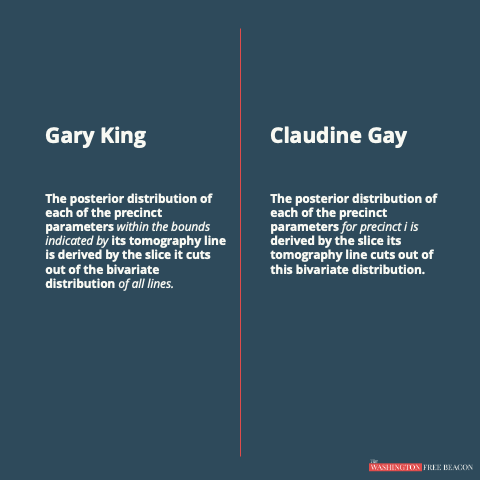
While some of Gay’s defenders have claimed that technical descriptions do not require attribution in the social sciences, since there are only so many ways to explain a method or a formula, a Harvard handbook from 1998—the year Gay completed her dissertation—says otherwise.
"Citing tells your readers that the strategy or method isn’t original with you and allows them to consult its original context," the handbook states. King, who has downplayed previous charges against Gay, did not respond to a request for comment.
The rest of the new examples center on a 1996 paper by Frank Gilliam, "Exploring Minority Empowerment: Symbolic Politics, Governing Coalitions and Traces of Political Style in Los Angeles," that Gay repeatedly quotes without attribution, changing just a few words here or there. Those passages describe big-picture findings and do not include technical verbiage. Gilliam, now the chancellor of the University of North Carolina-Greensboro, did notrespond to a request for comment.
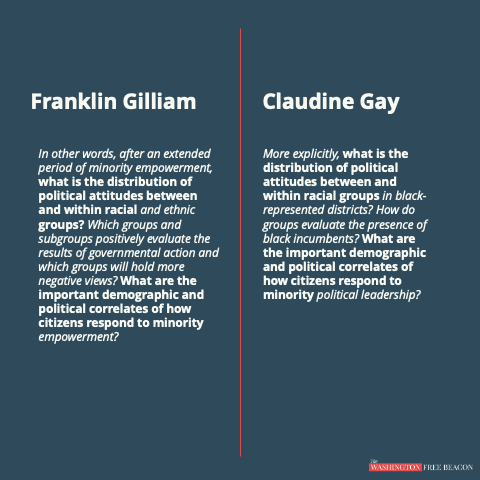
The new complaint comes as an increasing number of Harvard students are speaking out against Gay, arguing that she has been held to a lower standard than the average undergraduate. One student on Harvard’s honor council, a jury-like body that adjudicates allegations of plagiarism and cheating, wrote in an anonymous op-ed that students are routinely suspended for doing what Gay did. Some students have called on Gay to resign, and others seem reluctant to defend their embattled president.
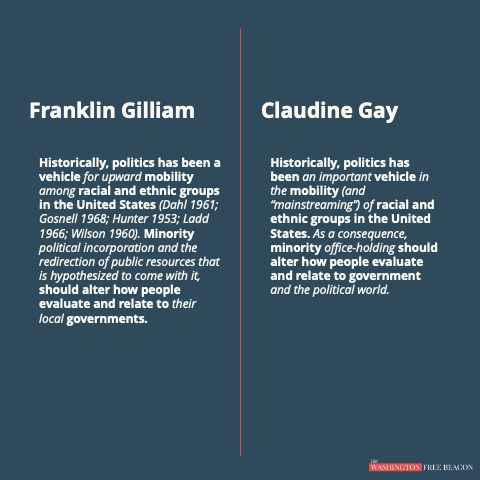
"President Gay Plagiarized, but She Should Stay," read the headline of a Harvard Crimson editorial. "For Now." The paper says the allegations of plagiarism are focused on "her PhD dissertation and two of her 11 published journal articles," leaving out the many allegations relating to articles that were not peer-reviewed.
The paper's qualified editorial position -- "for now" -- represents a shift in tone from the paper’s editorial board, which previously opined that—for the sake of a "free democracy"—Gay "must not yield" to "partisan attacks" in the wake of her disastrous testimony on anti-Semitism.
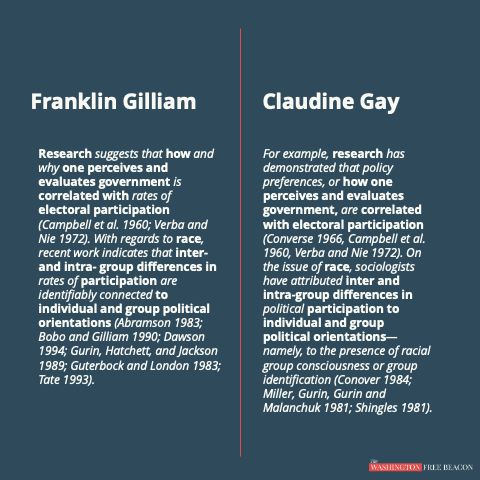
Gay’s most outspoken defenders have been her faculty colleagues. Randall Kennedy, a Harvard Law School professor, told the New York Times that the plagiarism charges were ginned up by "professional vilifiers" and "bad faith" actors—and went on to suggest the university may not cooperate with the congressional investigation underway into its adjudication of Gay’s work.
Another Harvard lawyer, Charles Fried, was more explicit, describing the allegations as an "extreme right-wing attack on elite institutions."
"If it came from some other quarter, I might be granting it some credence," he told the Times. "But not from these people."
Harvard said in December that Gay’s "duplicative language," while "regrettable," did not constitute research misconduct because it was not "intentional or reckless," citing a policy that only governs faculty and is less stringent than the rules for students.
But as more allegations have surfaced, some professors have begun to break ranks. A few told the Boston Globe in December that Gay’s treatment reeked of hypocrisy and double standards. And Omar Haque, a psychiatrist at Harvard Medical School and a member of the university’s Council on Academic Freedom, said that the sheer breadth of the examples—especially those from the pre-word processor days—made it hard to fathom that everything was unintentional.
"Gay's alleged plagiarism in the 1990s may be more serious than in in recent years," he told the Free Beacon, "because prior to the use of computers to highlight and copy/paste text in seconds, plagiarism was more likely to be non-accidental and intentional and reckless."
Haque, who said he was speaking only in a personal capacity, added that it took "greater effort" to plagiarize with a typewriter.
The blowback has been exacerbated by the Harvard Corporation’s feckless response to the allegations, which it initially tried to squash with a legal threat to the New York Post—and to the unnamed whistleblower who brought those allegations to the Post’s attention.
Through the bellicose litigation boutique Clare Locke, Harvard said in October that it would sue for "immense damages" if the Post published a story on the charges. It also "threatened to use legal means to out who had supplied the comparisons," according to the paper’s reporting.
That person, a professor at another university, whom the Free Beacon has identified and granted anonymity, is behind the Monday complaint to Harvard, as well as a separate complaint last month alleging around 40 cases of plagiarism. While several Harvard scholars have faced plagiarism allegations since the early 2000s, none have seen such a large percentage of their work implicated.
Beyond outlining the new charges against Gay, the latest complaint -- 25 pages of which are devoted to outlining the various examples of Gay's alleged plagiarism -- argues that Harvard’s legal saber-rattling violated its research misconduct policy for faculty, which forbids retaliation against complainants.
"At one point Gay and Harvard asked the Post, ‘Why would someone making such a complaint be unwilling to attach their name to it,’" the Monday complaint reads. "I was unwilling because I feared that Gay and Harvard would violate their policies, behave more like a cartel with a hedge fund attached than a university, try to seek ‘immense’ damages from me and who knows what else."
--

==
It is genuinely astonishing that this woman still has a job at all, never mind President of Harvard. This is why you never hire for diversity optics. When you don't make merit your number one priority, you have no idea if the person you're putting on is going to completely blow up your organization. And you can't get rid of them, because it looks like you're firing them because of their sex/race/etc., since you hired them for their sex/race/etc. in the first place.
#Aaron Sibarium#Claudine Gay#Claudine Gay is corrupt#plagiarism#Harvard#Harvard University#hypocrisy#academic fraud#academic integrity#academic corruption#religion is a mental illness
8 notes
·
View notes